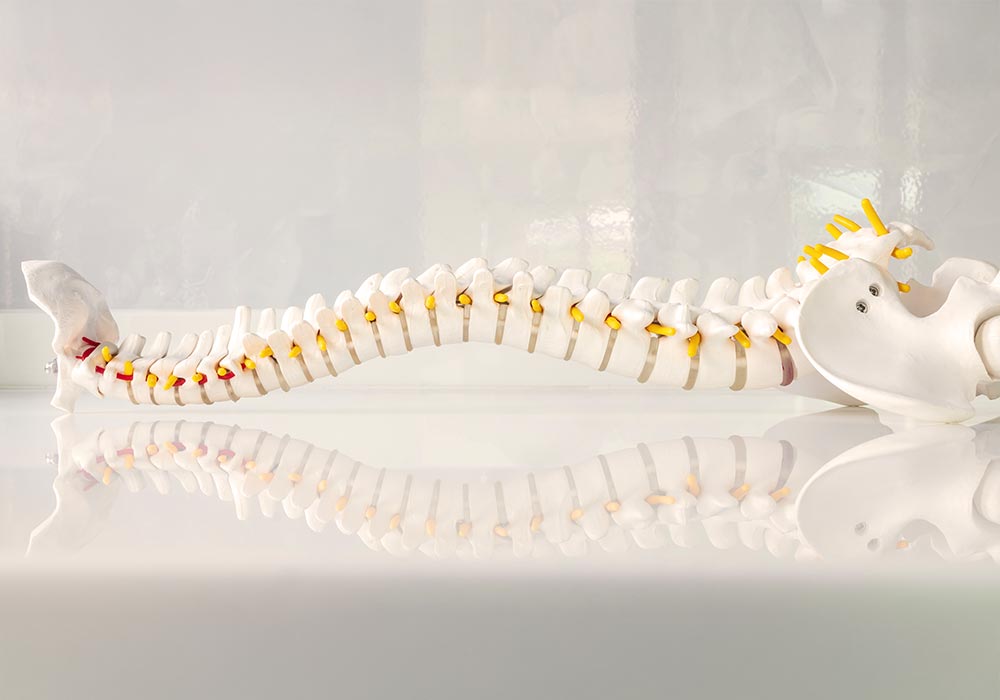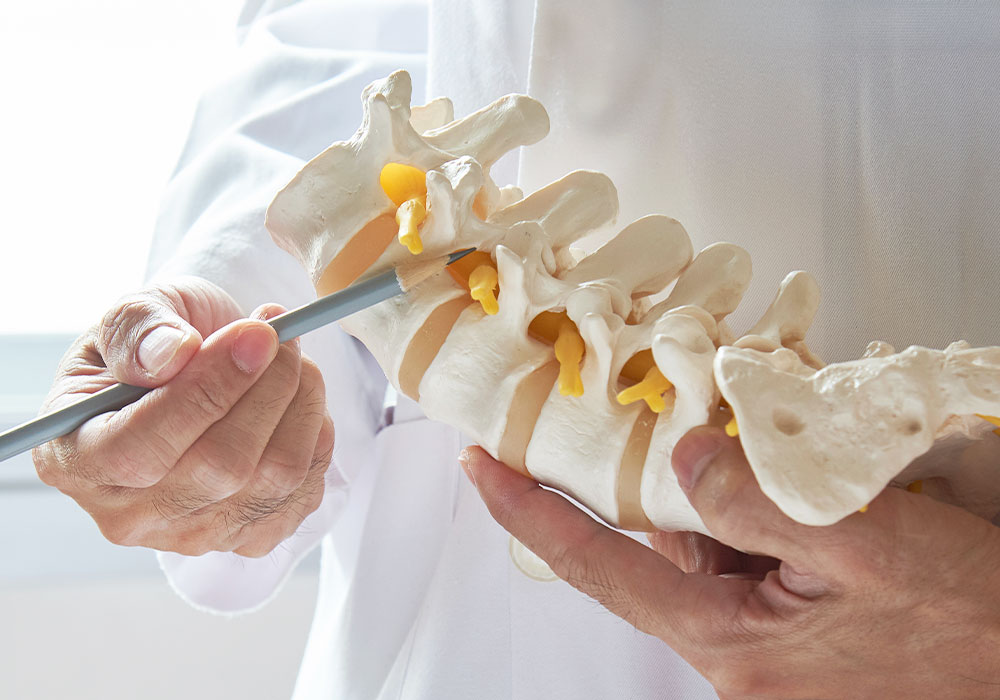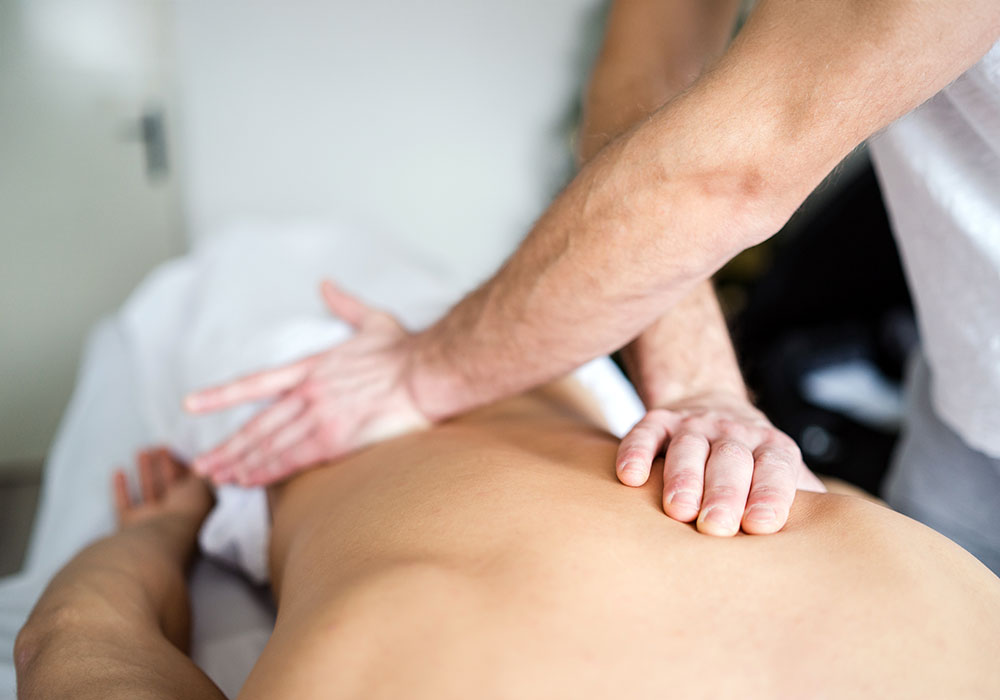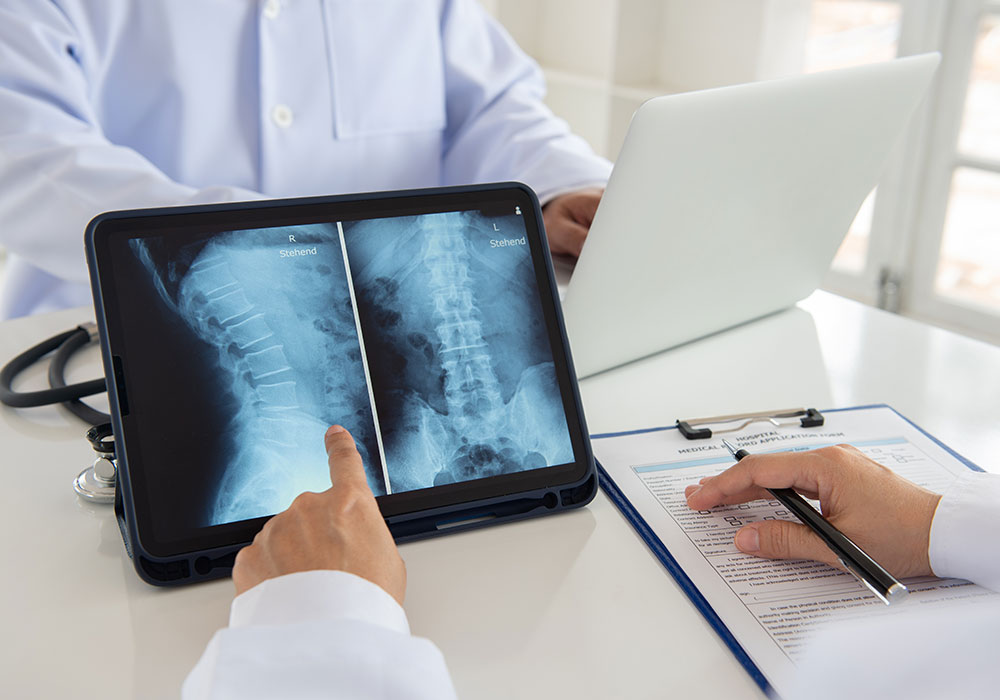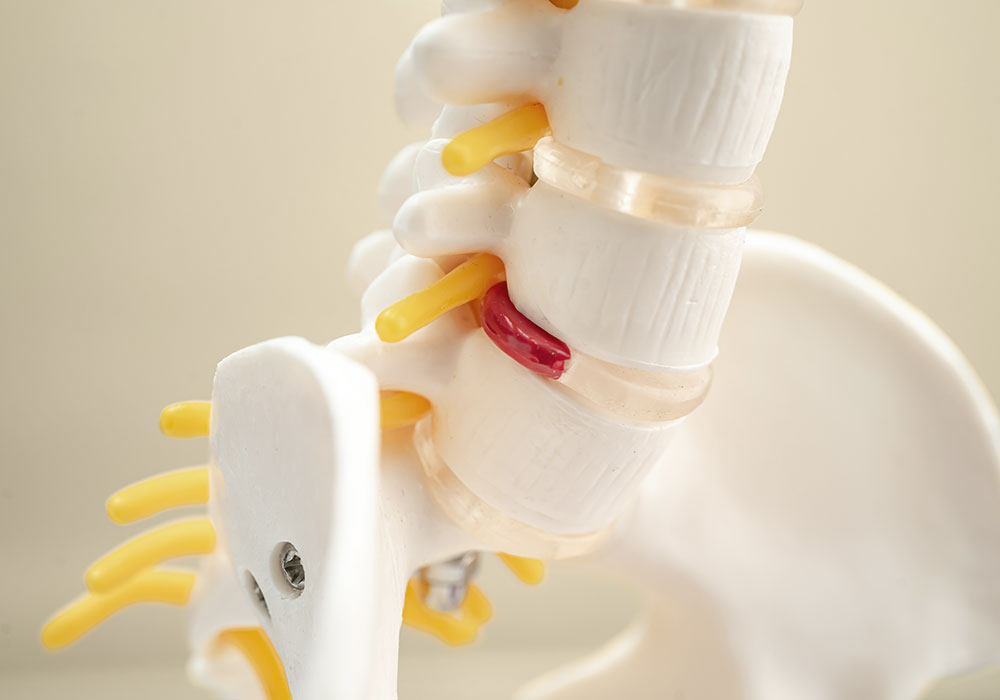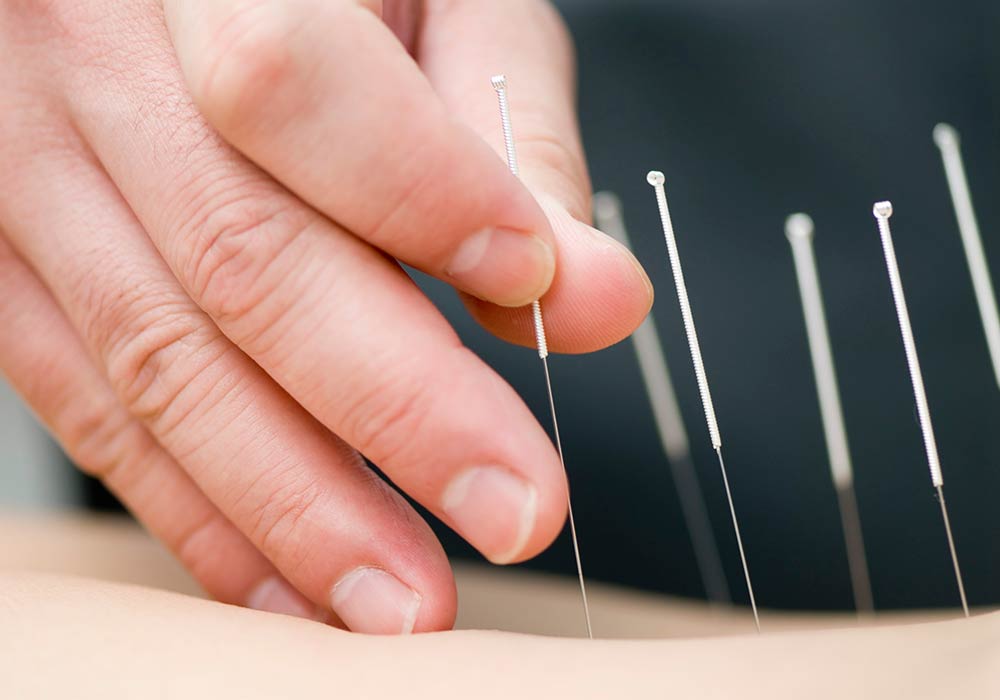Particularly when individual sections of the spine deviate permanently from their natural shape, this can not only affect the statics of the body, but also lead to serious health problems in the long term.
In principle, all visits to our private practice for orthopaedics & traumatology in Frankfurt are based on a detailed discussion about the cause, course, treatment options, etc. as well as a thorough physical examination. Only when the patient understands their clinical picture correctly can they support the treatment path with conviction.
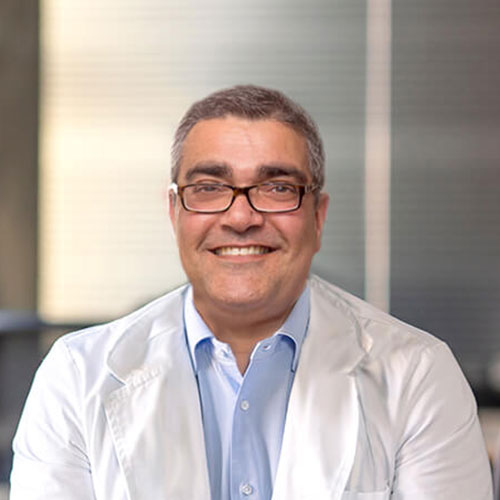
Dr. med. Nader Tabrizi

Dr. med. Stefan Chwalek

Dr. med. Isabella Gruber
The spine is a complex and flexible structure in the human body. It usually consists of 33, sometimes 34 vertebrae. These are divided into five sections:
- Cervical spine
It consists of 7 vertebrae (C1 to C7), which support the neck area and enable head movements. - Thoracic spine
The thoracic spine contains 12 vertebrae (Th1 to Th12). They are connected to the ribs and protect the rib cage. - Lumbar spine
The lower part of the spine consists of 5 vertebrae (L1 to L5). These carry most of the body’s weight and have the most mobility. - Sacrum and coccyx
This is where 4-5 vertebrae (S1 to S4/S5) merge. They are directly connected to the pelvis.
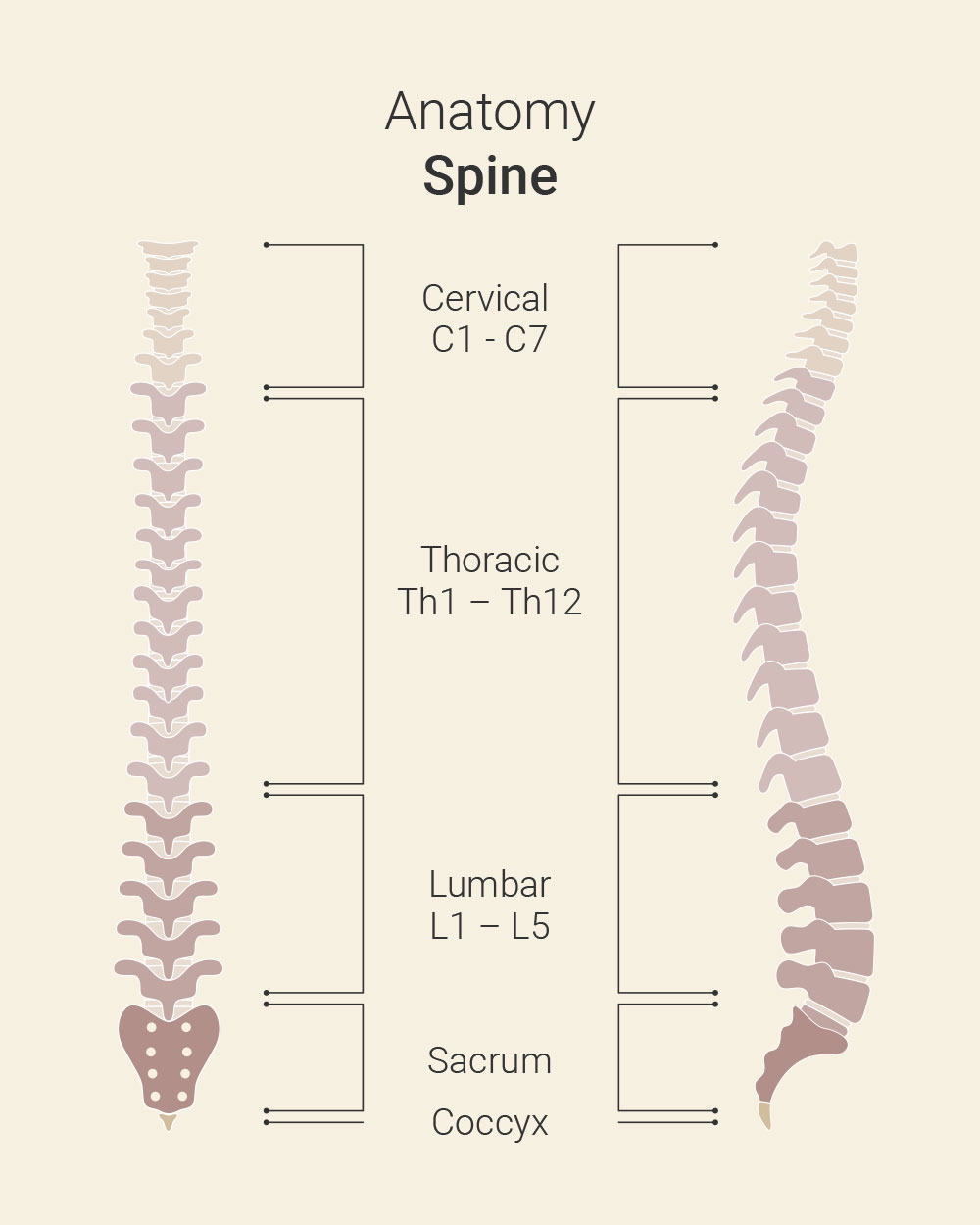
The vertebrae are the basic building blocks of the spine. As a specialized form of bone, they form a stable but flexible structure in their community. The vertebrae are structured as follows:
- Vertebral body (corpus vertebrae)
This is the front, stable part of a vertebra. The vertebral body forms the main part of the bone. It bears most of the weight and is separated from the neighboring vertebral bodies by intervertebral discs. It is usually circular or pear-shaped and consists of dense bone tissue. - Vertebral arch (arcus vertebrae)
This arch-shaped part, located behind the vertebral body, surrounds the spinal canal, which houses the spinal cord and nerve roots. The vertebral arch consists of two main parts: the transverse processes (processus transversus) and the spinous process (processus spinosus). The transverse processes are lateral processes that are connected to muscles and ligaments. The spinous process, on the other hand, is the backward-facing extension of the vertebral arch. Various muscles and ligaments also attach to it. - Vertebral joints (facet joints)
The vertebrae are connected to each other by joints known as facet joints. These small joints are located at the vertebral arches. They are covered with articular cartilage, which reduces friction and facilitates the movement of the vertebrae. - Intervertebral discs (Disci intervertebrales)
The intervertebral discs are located between the vertebral bodies. They consist of an outer fibrous ring (annulus fibrosus) that surrounds the inner nucleus (nucleus pulposus). The outer fibrous ring helps to maintain the structure of the intervertebral disc. The inner nucleus is designed to absorb shocks and keep the spine flexible. - Intervertebral foramina
There are openings between the neighboring vertebrae, the so-called intervertebral foramina. These openings form the space through which the nerve roots emerge from the spinal cord and enter the rest of the body.
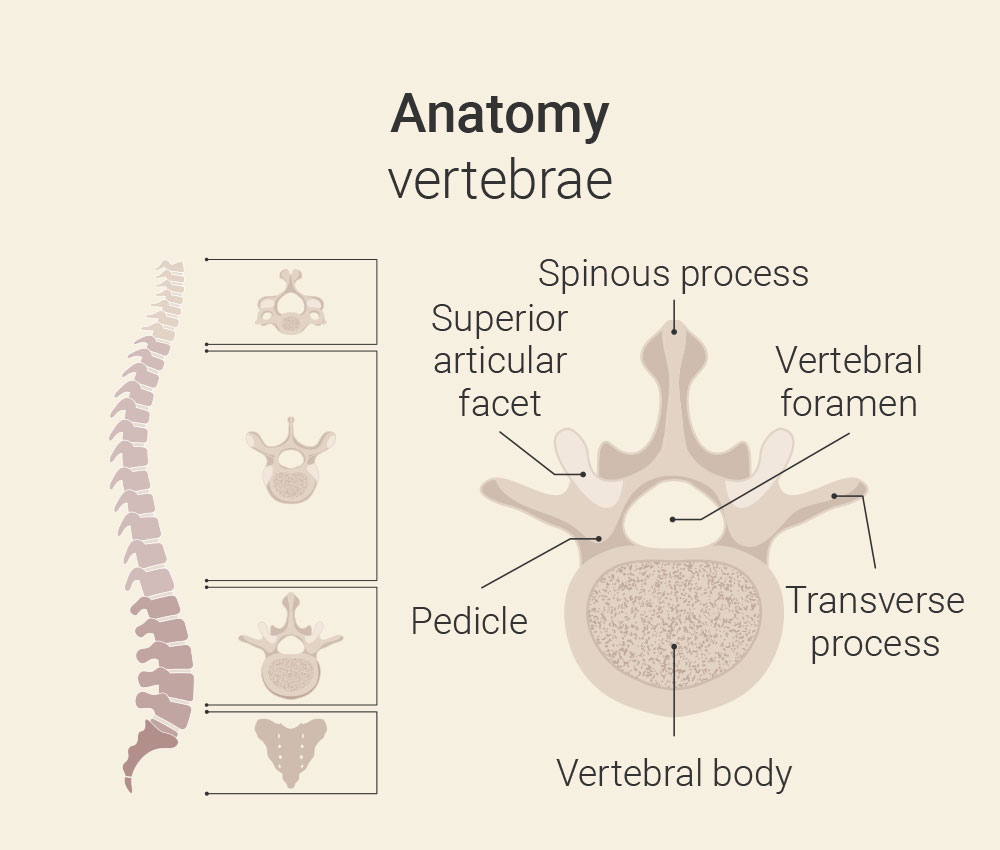
The vertebrae have several functions in the spinal column
- Support
The vertebral bodies support the body weight and give the spine its structural stability. - Protection of the spinal cord
Together with the spinal canal, the vertebrae form a protective environment for the spinal cord and nerve roots. - Mobility
They also enable the spine to perform complex movements such as bending, twisting and bending thanks to their joint connections. - Load distribution
As the vertebrae distribute the load evenly over the entire spine, they prevent excessive pressure on individual areas. - Support for the muscles and ligaments
They also provide anchor points for muscles and ligaments, which contribute to the stability and mobility of the spine.
The intervertebral discs are cartilaginous structures that are located between the individual vertebrae of the spine. They are structured as follows:
- Outer fibrous ring (annulus fibrosus)
This is the outer layer of the intervertebral disc and consists of concentrically arranged fibers of tight collagenous tissue. These fibers give the disc strength and help it maintain its structure. - Inner core (nucleus pulposus)
The inner part of the intervertebral disc consists of a gel-like core of water, collagen fibers and proteoglycans. It is elastic.
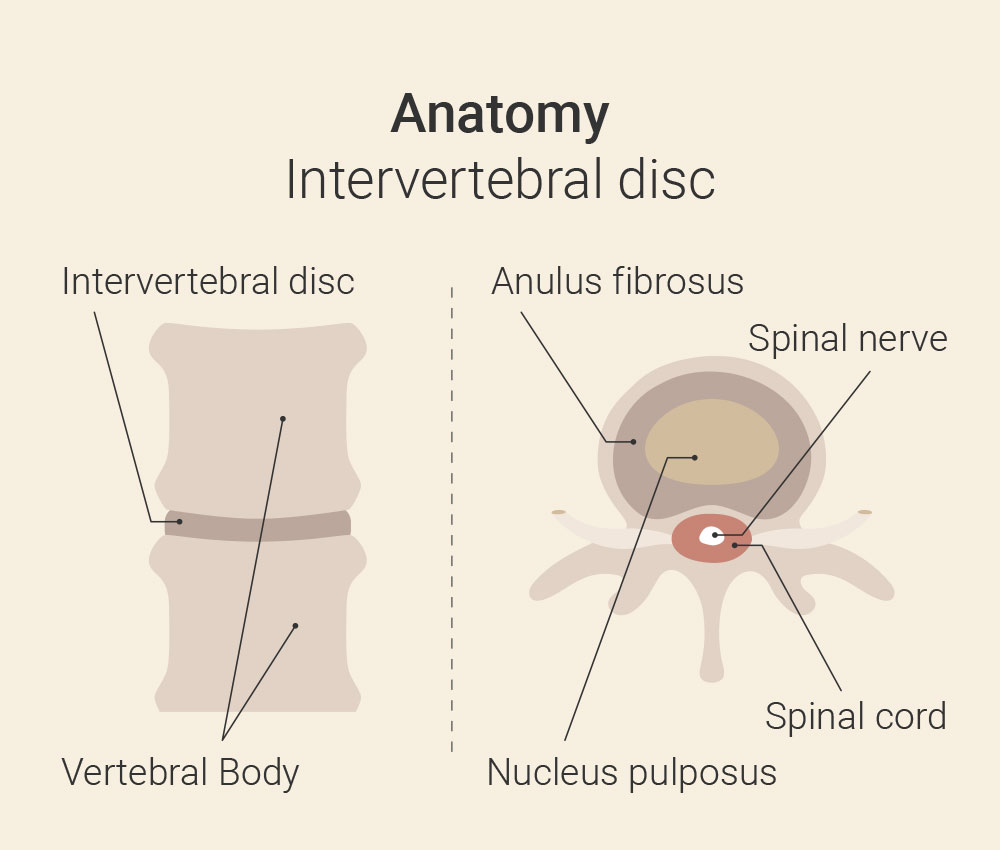
The intervertebral discs have the following functions:
- Shock absorption
The main function of the intervertebral discs is to protect the spine from shocks and stresses. They absorb the forces that act on the spine during walking, running, jumping and other activities and distribute them evenly across the vertebral bodies. - Flexibility and mobility
The intervertebral discs act as flexible connecting elements between the vertebral bodies. In this function, they enable the spine to bend in different directions. - Load distribution
The intervertebral discs also help to distribute the body weight evenly across the spine. They prevent the vertebral bodies from rubbing directly against each other. Healthy intervertebral discs can therefore also reduce wear and tear and degeneration of the vertebrae. - Nutrition of the vertebral bodies
The intervertebral discs are not just passive structures, but are also actively involved in nourishing the surrounding tissue. They receive nutrients through diffusion, as they do not have their own blood vessels. Exercise promotes the diffusion of nutrients into the intervertebral discs and thus supports their health.
The spinal cord is an organ of the central nervous system located within the spinal canal of the spinal column. It plays a crucial role in the transmission of information between the brain and the rest of the body. What you should know about the spinal cord:
- Location
It runs along the spinal canal, starting at the bottom of the brain (brain stem) and ending at about the first or second lumbar vertebra. It is protected by the vertebral bodies and their arches as well as the intervertebral discs and the ligamentous structures of the spinal column. Ligaments are ligaments and tissue structures that connect and stabilize the various parts of the spine. - Tissue structure
The spinal cord is surrounded by three layers of membranes, the so-called meninges. The dura mater is the outer, tough membrane that surrounds the spinal cord and the brain. The middle layer, which runs between the dura mater and the inner layer, is called the arachnoid membrane. The pia mater, which lies close to the spinal cord and directly envelops it, is the inner layer. The spinal cord itself is located within these membranes. - Components of the spinal cord
The spinal cord contains a collection of nerve cells (neurons) and nerve fibers (axons). It can be divided into gray matter and white matter. The gray matter is located in the middle of the spinal cord and consists mainly of nerve cell bodies. The white matter surrounds the gray matter. It is formed from nerve fibers that conduct nerve impulses between the spinal cord and the brain as well as to other parts of the body. These structures are embedded in cerebrospinal fluid, a clear, colorless liquid. It consists of around 99% water, but also contains small amounts of electrolytes such as sodium, potassium, calcium, chloride, glucose and proteins.
The spinal cord has various functions:
- Transmission of sensory information
The spinal cord plays a key role in the transmission of sensory information (such as sensations of touch, temperature and pain) from the periphery (skin, muscles, joints) to the brain. - Transmission of motor information
It also transmits motor information from the brain to the muscles and other target tissues in the body. This information controls muscle contractions and enables the execution of movements. - Reflexes
The spinal cord is also responsible for controlling reflexes, which are quick, involuntary reactions to stimuli. Reflexes such as the hamstring reflex or the pupillary reflex allow the body to react quickly to potential dangers or changes in the environment without the need for conscious processing in the brain.
The spinal cord is therefore crucial for communication between the central nervous system (brain and spinal cord) and the peripheral nervous system (nerves in the arms, legs and organs). It acts as a link that enables the body to respond to external stimuli, perform movements and process information that is essential for vital functions.
Various nerves run through the spinal column, each of which fulfills specific functions:
- Spinal cord nerves (spinal nerves)
They emerge from the spinal cord in pairs at almost every level of the spinal column. There are 31 pairs of nerves in total. Their main task is to transmit sensory information (such as touch, temperature, pain) from the skin, muscles and joints to the spinal cord. They are also responsible for transmitting motor information from the spinal cord to the muscles and organs. The spinal nerves are divided into different sections that innervate the corresponding areas of the body. This means that nerves lead to a specific body part or organ and supply it with nerve impulses to control or regulate its functions. The cervical spine innervates the neck, shoulders, arms and hands. The thorax, chest muscles and internal organs are supplied by the spinal nerves of the thoracic spine. The lumbar spine is responsible for the lower back region, hips, legs and feet. The sacrum and coccyx innervate the lower back, pelvis and lower abdomen. - Nerves of the back muscles
These nerves supply the muscles of the spine and back with motor signals that are important for movement and posture. - Nerves of the autonomic nervous system
The spinal column also contains nerve fibers of the autonomic nervous system, i.e. the part of the nervous system that automatically and unconsciously regulates vital bodily functions such as heartbeat, breathing, digestion and metabolism.
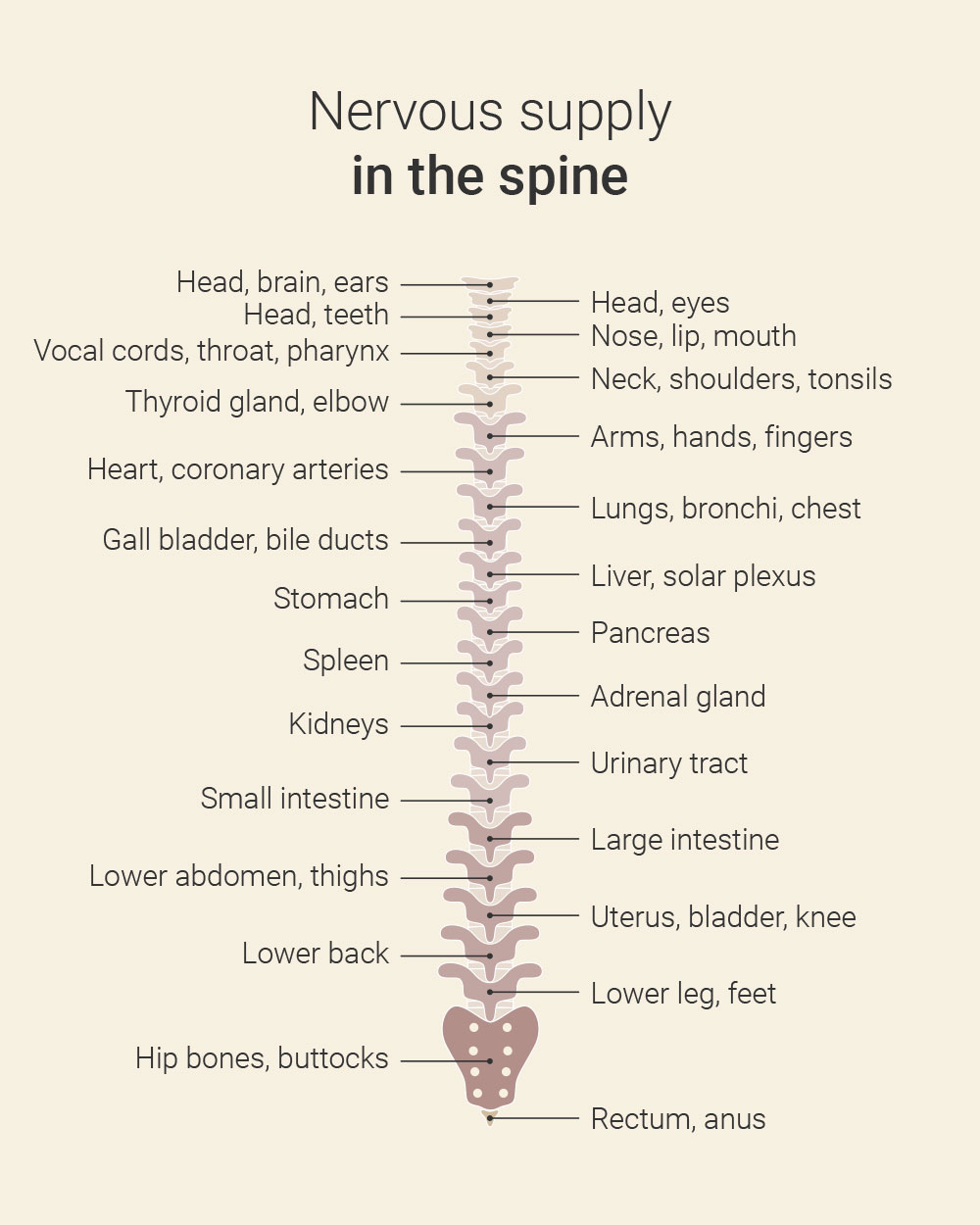
There are various diseases of the spine, which have different causes, symptoms and treatment options. In our private practice for orthopaedics and traumatology in Frankfurt, you can rely on careful diagnostics and modern treatment. The most common diseases of the spine include
- Vertebral blockage
This is a blockage of a vertebra, often caused by muscle tension or incorrect movements. It can be accompanied by pain and limited mobility. Find out more: Release vertebral blockage in Frankfurt - Bulging disc
With a bulging disc, part of the inner core of the disc pushes outwards between the vertebrae, but does not break through its outer shell. This can press on nerve roots or other structures and lead to symptoms such as pain, numbness or tingling. More information: Treating a bulging disc in Frankfurt - Herniated disc
If the soft core of the intervertebral disc breaks through the outer fibrous ring, this can lead to pain, numbness and neurological symptoms. Further information: Treating a slipped disc in Frankfurt - Spinal canal stenosis
This is a narrowing of the spinal canal that exerts pressure on the spinal cord and nerve roots. Stenosis is usually accompanied by pain, numbness and weakness in the legs. - Spondylarthrosis
Spondylarthrosis, a degenerative disease of the vertebral joints, is also painful. It usually also causes movement restrictions. - Spinal deformities
Malformations or misalignments of the spine, such as scoliosis, are also possible. The lateral curvature of the spine often begins in childhood. It leads to an uneven shoulder or pelvic height, which can result in various complaints. Another spinal deformity is spina bifida. - Osteoporosis-related vertebral fractures
Vertebral bodies weakened by osteoporosis can break more easily, which can lead to severe back pain. Find out more about the disease and its treatment here: Osteoporosis Frankfurt - Tumors of the spine
Tumors can develop primarily in the spine or metastasize from other organs, which can cause pain and neurological symptoms.
A “clean” diagnosis is important for successful therapy. In order to maintain this, a detailed medical examination, a thorough physical examination and purposeful diagnostics are required. From this, a concept for treatment is defined together.
A method where local anesthetics and anti-inflammatory substances are injected into a painful region within the vicinity of nerves or muscle hardenings.
Inflammations in the small vertebral joints, the area of the nerve exhalation holes and inflammations in the ligaments and tendons on the vertebral column can be influenced until healed.
A CT (Computer Tomography) -controlled injection of an inflammatory inhibitor (usually cortisone-containing solution) is given in the immediate vicinity of a herniated disc, an otherwise compressed nerve root or joint inflammation with close monitoring. Very precise and with little risk. It is extremely successful with an improvement rate of > 80%.
Elimination of minor dislocations of joint partners by using special handgrips. These so-called subluxations (incomplete dislocation of a joint) frequently occur in the spine and the Sacroiliac joints (Iliac Crest joint).
While on a special treatment bed, gentle longitudinal pulls and the simultaneous application of heat provide relief from painful muscle tensions and joint blockages in the cervical and lumbar spine. An ancient and proven principle within manual medicine.
A uniform effect can be achieved rapidly through a combination of substances intravenously. the Infusion therapy is helpful for patients with gastrointestinal complaints, therapies that rely on blood thinners as well as other basic diseases which do not allow for the oral intake of tablets.
The correct execution of passive and active physiotherapeutic treatments is an essential part of successful spinal column treatment. This approach is a medium to long-term stabilization of the desired situation. An individually compiled program is co-ordinated for each patient and adjusted as necessary.
The principle is based on a relaxing or stabilizing effect on the muscles or joints, depending on the technique and the material used. The effect in the muscles or joints is mediated via the skin and the subcutaneous tissue. Kinesio-Taping has been widely used in recent years, but has been used in orthopedics since the 1970s. It was developed by the Japanese chiropractor Kenzo Kaser.
Body-specific pain-inhibiting systems are activated by needles in defined skin regions. The origin of this practice dates back to 200 years before Christ.
Spinal canal stenosis leg pain
Vertebral blockage is a condition that often causes severe discomfort and can significantly restrict mobility. In the following, we will explain and show you how we can treat this condition.
What is a vertebral blockage?
Vertebral blockage is a condition that often causes severe discomfort and can significantly restrict mobility. In the following, we will explain and show you how we can treat this condition.
Chiropractic thoracic spine: alleviating discomfort in the thoracic spine
The thoracic spine plays a crucial role in our daily lives. Chiropractic offers a promising solution for various complaints in the thoracic spine.
Treating a bulging disc: What you need to know
One possible and common cause of back pain is a bulging disc. This condition can significantly affect quality of life and make daily activities a challenge.
Lower back pain: What could it be?
Back pain is widespread and affects most people at some point in their lives. Below we show you possible causes and explain how we can treat them.
Slipped disc treatment: these options are available
The choice of treatment for a slipped disc depends on your individual situation and your symptoms. We work closely with you to treat your slipped disc.
Neural therapy Frankfurt
Neural therapy according to Huneke is a low-pain form of therapy that can relieve pain and activate the body’s self-healing powers. The procedure represents a link between naturopathic methods and classical orthodox medicine.
Acupuncture for back pain
Back pain is a common health problem and a real widespread disease that can affect people of all ages. For complaints in the back, we offer acupuncture in our private practice for orthopedics and traumatology in Frankfurt.
